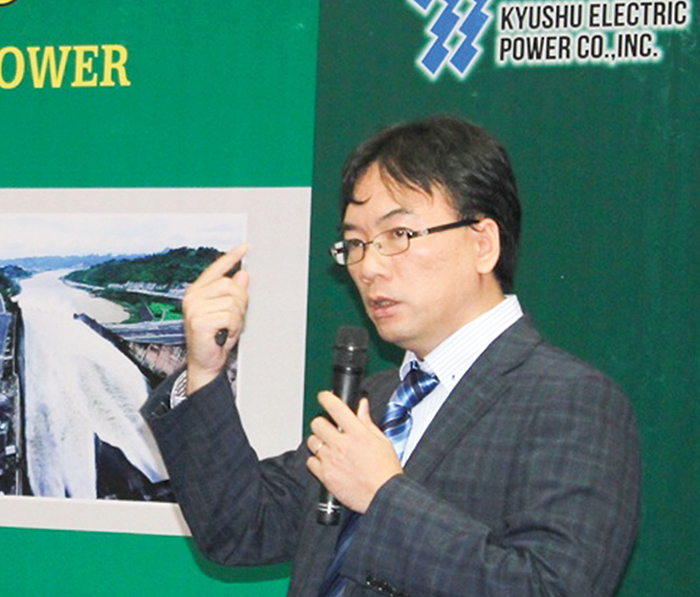
Mr. Ha Ngoc Tuan
Reporter: Could you please tell us Japan's experience in analyzing and operating hydropower dams and reservoirs in real time?
Mr. Ha Ngoc Tuan: Since 1996, Kyushu Electric Power Corporation of Japan has developed and applied an integrated system in operation of hydropower dams and reservoirs. This system provides forecasting information, hydro-meteorological information of the river basin and reservoir together with operation conditions of the hydropower plant in real time, contributing to the use of human resources in a more appropriate way, operating the power plant in a safer and more efficient manner than other power plants in the same river.
In Vietnam, as far as we know, the operation of hydropower plants is analyzed manually, water inflows in the reservoir are determined according to predetermined timelines. Besides, the forecast of rainfalls and water inflows in the reservoir is limited, due to the fact that it has yet to be technically capable of forecasting for each power units in the reservoir basin.
Reporter: It is known that Kyushu Electric Power Corporation has supported and tested this analysis model at some hydropower plants in Vietnam. Could you tell us the test results?
Mr. Ha Ngoc Tuan: We have signed contracts with 5 reservoirs for testing our operation assisting technical services. Under the terms of the contract, we are not permitted to make public the test results without the consent of our Vietnamese partner.
However, the test results in a hydropower reservoir in Lang Son province (where a part of the test results can be published) has showed that the plant has significantly increased its revenue by saving water in the dry season and catching early floods thanks to beforehand forecasts. Moreover, the operation of the reservoir when the flood comes has been performed very effectively in accordance with regulations and procedures, the flood discharge has been promptly notified and performed in compliance with regulations.
Reporter: Many hydropower plants on the Da River have large capacity sizes and reservoirs, but the upstream areas are located in China where Vietnam face difficulties in proactively and promptly analyzing and updating data. So, can the model of Kyushu Electric Power Corporation overcome this constraint?
Mr. Ha Ngoc Tuan: The Da river system of Vietnam with the basin area spreading to Hoa Binh hydropower dam is very large, of which about 46.6% of the basin area belongs to Chinese territory. Vietnam will be passive in forecasting rainfalls in the basin area of China, and in lack of operational information of dams in this neighboring country.
Regarding the rainfall forecasting, according to our partner, their weather model covers Chinese territory and moreover they have collaborative relationships in collecting rainfall monitoring data. Therefore, the rainfall analysis and forecast model can be adapted in the basin of Chinese territory. However, the challenge here is how to adapt the runoff forecast model, which requires historical statistics, including rainfall and runoff as well as river morphological information. Therefore, it is necessary to have an international cooperation to collect accurate data, otherwise we can only use relative forecasting models to provide runoff information.
In addition, we believe that information on dams and reservoirs in Chinese territory is also essential for the operation of cascaded hydropower plants on the Da River.
Reporter: Many river basins in the Central region and Central Highlands are very short, steep, floods come and leave very quickly. Will it cause any difficulties in analyzing, sir?
Mr. Ha Ngoc Tuan: The topographical conditions of rivers in Japan are similar to those of the river basins in the Central region and Central Highlands of Vietnam. It is not difficult at all to analyze operation, provided that flood statistics must be sufficiently available (data on 8 - 10 large and small floods in the past is needed). Therefore, in basins where adequate data has yet to be available, it is necessary to embark on the observation and monitoring in an early manner. We have a team of experts who are very experienced in model adaptation, who can be of great assistance to Vietnam.
Reporter: It is known that this analysis model of Kyushu Electric Power Corporation is quite costly, not affordable to all hydropower plants?
Mr. Ha Ngoc Tuan: A perfect integrated system for operating hydropower dams and reservoirs in Japan as the system being applied in Thua Thien Hue costs USD 18.2 million, which is sponsored by JICA. It is true that at such a high price, in the near future, it is difficult to put into application in Vietnam's dam and reservoir systems.
Therefore, our idea is to apply basic functions of the Japanese integrated operation system to dams and reservoirs in Vietnam. It is possible to save costs by utilizing recent scientific and technological advances such as IoT, taking advantage of available information resources from the Vietnam Meteorology and Hydrology industry, etc. We desire to introduce the system in the operation of hydropower dams and reservoirs in Vietnam with a small initial cost, then using part of the added economic value (thanks to the economic efficiency of the system) to pay for costs of services that we provide. Taking into account the additional economic efficiency thanks to using our system and the potential of alleviating possible damages caused by dam or reservoir incidents that may occur, we believe that the system is not too expensive.
Reporter: Thank you!